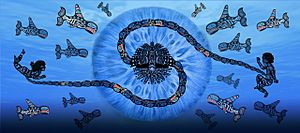Uvavnuk facts for kids

Uvavnuk was an Inuk woman who lived in the 1800s. She is known as a talented oral poet. Her amazing story of becoming an angakkuq (a spiritual healer) and the special song she received were written down by European explorers in Arctic Canada in the early 1920s. Her powerful poem-song, often called "Earth and the Great Weather", has been shared in many collections of poems.
Contents
Uvavnuk's story was first written down by an explorer named Knud Rasmussen. He grew up speaking Greenlandic, which is a language very similar to Inuktitut, the language Uvavnuk spoke.
Her story was told to Rasmussen by Aua, who was a cousin of Uvavnuk's son, Niviatsian. Both Aua and Niviatsian were also spiritual healers. Aua helped Rasmussen by sharing many cultural stories and songs.
Rasmussen and Aua met in February 1922, near Lyon Inlet, which is north of Hudson Bay. Because of where she lived, Uvavnuk is considered an Iglulingmiut, meaning she was from Igloolik. Aua lived in a small community of 16 people, all related to him and to Uvavnuk.
Rasmussen's version of Uvavnuk's story was published in a book called The Intellectual Culture of the Copper Eskimos in 1932. This book was part of a larger series about his travels. The story was first spoken in Inuktitut, then written in Danish, and later translated into English.
Another explorer who traveled with Rasmussen, Peter Freuchen, also wrote about Uvavnuk. In his 1961 book, Book of Eskimos, Freuchen shared a slightly different version of her story.
Uvavnuk's Spiritual Journey
Rasmussen titled Uvavnuk's story "Uvavnuk is struck by a ball of fire." He believed this "ball of fire" was a meteor. This is the main story about her in his book.
One dark winter evening, Uvavnuk went outside her hut. Suddenly, a bright ball of fire appeared in the sky and flew straight towards her. Before she could move, the ball of fire hit her and went inside her body. At that moment, she felt a bright light fill her, and she fainted.
From that moment on, Uvavnuk became a powerful shaman, or spiritual healer. She had never tried to connect with spirits before. But now, the spirit of the meteor, called imiEru'jap inua, had entered her and made her a shaman. Just before she fainted, she saw the spirit. It looked like it had two parts: one side was like a bear, and the other was like a human. Its head was human, but it had bear tusks.
Uvavnuk fell down and lost consciousness. But then she got up and ran back into her house, singing. She now knew everything that was hidden. She began to tell everyone in the house about any wrong things they had done. By doing this, she helped to make them all feel pure and good again.
What was special about Uvavnuk was that when she came out of her trance, she felt like a normal person again. The special light left her body, and she no longer had her shaman powers. She only became a powerful spiritual healer when the meteor spirit lit up the spiritual light inside her.
Before she passed away, Uvavnuk held a very important spiritual gathering. She said that she wanted people to have enough food and not suffer. She "manivai," which means she brought forth all kinds of animals from inside the earth. She said she got these animals from Takånakapsåluk, a powerful spirit. After she died, the people in her village had a year with more whales, walruses, seals, and caribou than ever before.
Uvavnuk's Famous Poem
The words Uvavnuk sang are known by several names, including "The Great Sea," "The Song of Uvavnuk," and "Earth and the Great Weather." There are many English versions of her song. Some were translated from Danish, and some directly from Inuktitut. The poet John Robert Colombo said that "The song's power is such that its spirit vaults the hurdles of translation with ease." This means the song's message is so strong that it comes through clearly, even when translated.
Peter Freuchen, Rasmussen's companion, translated what is considered the longest and most touching version of the song. Here is a part of it:
The great sea moves me, sets me adrift.
It moves me like algae on stones in running brook water.
The vault of heaven moves me.
Mighty weather storms through my soul.
It carries me with it.
Trembling with joy.
Uvavnuk's poem has appeared in many collections of writings. These include Northern Voices: Inuit Writing in English (1992) and The Enlightened Heart: An Anthology of Sacred Poetry (2009). The poem is used in many different ways. For example, it helps people understand the differences between an archaeologist's life and an Inuk's life in the past. It has also been used in mystery novels and by outdoor educators to connect nature and culture.
In 2019, the Icelandic explorer Fiann Paul recited Uvavnuk's poem on camera when he arrived in Antarctica.
Music Inspired by Uvavnuk
Uvavnuk's song, in its original Inuktitut language, was used in a musical piece by American composer John Luther Adams. He called his 1995 work Earth and the Great Weather, using a phrase from her song as the title.
In 2006, Theodore Wiprud created "Three Mystical Choruses." One of these five-minute pieces was based on Uvavnuk's text. This music was written for the Young People's Chorus of New York.
The 1995 recording of "Earth and the Great Weather" was also used in the Oscar-winning film The Revenant (2015). However, it was used as a voiceover for a Pawnee character, even though the Pawnee language is very different from Inuktitut.
See also

